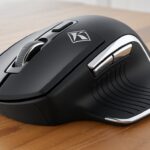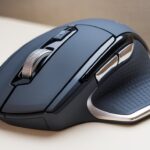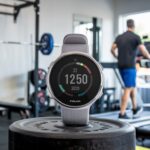In the ever-evolving landscape of modern workspaces, trackballs are making a notable comeback. Once seen as a niche accessory, these unique devices are gaining traction among office workers and gamers alike.
Their design offers an intriguing alternative to traditional mice, promising not just enhanced functionality but also an opportunity for better ergonomics. As more individuals seek comfort during long hours of computer use, it’s no wonder that trackballs are finding their place in cubicles, gaming setups, and beyond.
Ergonomics plays an essential role in maintaining health and productivity. With increasing concerns about repetitive strain injuries and discomfort from prolonged computer use, professionals are on the lookout for solutions that promote a healthier workspace.
Trackballs hold the potential to minimize wrist strain while allowing users to maintain a natural hand position. Whether you’re navigating spreadsheets or immersing yourself in epic gaming battles, incorporating ergonomic tools like trackballs may be the key to unlocking a more comfortable experience. Intrigued?
What is a Trackball?
A trackball is an input device that allows users to control the cursor on their screens by rotating a ball mounted in its housing. Unlike traditional mice, which require you to move the entire device across a surface, trackballs remain stationary.
This unique design not only enhances ergonomics but also maximizes precision and efficiency. Users simply use their fingertips, thumb, or palm to roll the ball in any direction they wish to navigate. This method can feel more intuitive for those who struggle with wrist movement or have limited desk space.
When it comes to types of trackballs, there is a range of options available for varying preferences and needs. Some models feature a larger central ball, providing broader and smoother movements—ideal for graphic designers who need finer control over their cursor’s positioning.
Others may emphasize portability with compact designs suited for laptops or mobile setups, allowing on-the-go professionals to maintain ergonomic standards wherever they work.
Additionally, many contemporary trackballs come equipped with customizable buttons that enable shortcuts for frequently used commands, catering perfectly to both office workers who multitask and gamers seeking competitive advantages.

Many users find that transitioning from a mouse to a trackball yields enhanced comfort during extended usage sessions since compared to grasping a mouse and lifting it repeatedly off the surface can lead to fatigue and strain over time.
Furthermore, because your hand remains in a neutral position while operating the trackball—typically slightly elevated above the workspace—you can significantly reduce tension not just in your wrists but also throughout your arm and shoulder regions as well.
In summary, understanding how a trackball operates compared to traditional mice reveals its potential benefits for diverse segments of users—from dedicated office professionals managing everyday tasks to gamers immersed in intense competition.
With various models designed for specific use cases, incorporating this innovative tool into your setup could unlock new levels of comfort and functionality you never knew existed.
The Ergonomic Benefits of Using a Trackball.
Switching to a trackball can significantly reduce wrist strain, fostering a more comfortable computing experience. Traditional mice require users to engage in repetitive wrist movements as they navigate across a surface, often leading to discomfort and even chronic issues like carpal tunnel syndrome.
However, with a trackball, your hand remains stationary while the ball is manipulated with your fingers. This change in mechanics not only keeps your wrist at a neutral angle—essentially preventing bending and twisting—but also alleviates the tension that comes with continuous movement.
Moreover, using a trackball can lessen muscle fatigue during long hours at the desk, which many office workers and gamers encounter. With traditional input devices, extended use leads to strain on various muscle groups in the arm and wrist due to constant adjustment and repositioning of the mouse.
On the contrary, trackballs allow your fingers to do most of the work; this means less overall exertion from larger muscle groups while still maintaining precision. You might notice that after several consecutive hours of work or gaming sessions, your grip feels lighter and less strained compared to standard mouse use.
Additionally, incorporating a trackball into everyday tasks doesn’t merely benefit physical comfort—it may also enhance productivity. By allowing for easy access to many buttons directly at the fingertips without needing excessive movement, users can toggle between applications or functions smoothly.
The ergonomic design promotes longer periods of focused time without distraction or discomfort from bodily strain. For someone engaged in meticulous graphic design projects or high-paced gaming sessions, these ergonomic advantages come as an invitation to stay fully immersed without feeling trapped by their own equipment.
In essence, making the switch from a conventional mouse to a trackball paves the way for healthier habits at work or play.
Whether you’re battling exhaustion at an office meeting or diving into an intense gaming session late into the night, embracing this versatile device could be just what you need to revolutionize how you interact with technology—and it all begins with reducing those nagging aches and pains that slow us down over time.
Improved Precision and Control.
When it comes to tasks that require a fine touch, precision can be the difference between success and frustration. This is particularly evident in fields like graphic design, where every pixel matters, or in gaming, where accuracy can mean the difference between victory and defeat.
Trackballs excel in these scenarios. By utilizing finger movements rather than wrist or arm movements, trackballs allow for more nuanced control over the cursor.
For example, a digital artist might find that adjusting the finer points of their artwork becomes smoother and more intuitive when using a trackball, as they can make delicate adjustments without having to lift their hand off the surface.
The comparison between trackball accuracy and traditional mouse usage highlights some compelling advantages. While standard mice require broad sweeping motions that can sometimes lead to overshooting or undershooting target areas on-screen, trackballs permit minute adjustments with little effort.
This reduced requirement for large movements not only minimizes strain but allows users to maintain more consistent speed and accuracy—essential in high-stakes gaming situations such as first-person shooters where every action counts.
Players often report an increased ability to perform complex maneuvers thanks to the precise nature of trackball navigation.
In addition to enhanced precision for individual tasks, using a trackball can lead to improved workflow efficiency overall. Multitasking becomes less cumbersome because users can quickly toggle between applications without extensive hand movement across their desks.
This organizational benefit also plays into productivity; professionals handling various tasks at once may find that they can switch contexts with ease when relying on a device designed for fine motor skill engagement.
Ultimately, whether you’re illustrating intricate designs or aiming for headshots in your favorite game, the benefits of improved precision and control provided by a trackball make it an appealing choice for anyone seeking better performance combined with ergonomic advantages.
Compatibility with Various Work Styles.
Trackballs offer remarkable versatility, making them an excellent choice for both office workers and dedicated gamers alike. In a typical office setting, professionals often juggle multiple tasks—from data entry to creative design.
The stationary nature of a trackball allows users to maintain a comfortable wrist position while navigating through spreadsheets or graphic design software.
For instance, individuals engaged in prolonged computer use can benefit from the reduced arm movement required by trackballs, allowing them to focus more on their work and less on discomfort.
In the gaming realm, precision and efficiency are paramount. Trackballs provide gamers the refined control needed for complex maneuvers in fast-paced environments.
Take first-person shooters as an example: the fine-tuned movements enabled by a trackball can lead to better aiming accuracy without the extra hand motion associated with traditional mice.
Gamers have noted that switching to a trackball allows them to improve their performance significantly, particularly during intense gaming sessions where every millisecond counts.
Trackballs also support various activities beyond basic work or gaming functionalities. They adapt seamlessly to multitasking scenarios such as video editing or 3D modeling—where precise cursor movements combined with larger button configurations become essential.
By providing effortless flicks for quick navigation during timelines or zooming in on intricate designs, trackballs enhance user productivity while ensuring ergonomic support remains at the forefront of any endeavor.
Ultimately, whether you’re crafting an intricate document or diving into a competitive gameplay session, the adaptability of trackballs makes them not just tools but clever companions tailored to varied work styles.
Their ability to bridge comfort with functionality presents an opportunity for increased productivity across diverse environments—a true advantage that modern professionals and gamers can’t afford to overlook.
Addressing Common Concerns About Trackball Use.
One of the most prevalent misconceptions about switching from a traditional mouse to a trackball is the fear of an overwhelming learning curve. Many potential users worry that mastering the mechanics of a trackball will take considerable time and effort, ultimately hindering their productivity.
However, it’s essential to understand that while there may be an initial adjustment period, most users find they adapt much quicker than anticipated.
A simple analogy might help; think of it like switching from using a broom to a vacuum cleaner for cleaning your home. At first, it can feel slightly different in handling, but with just a bit of practice, you’ll quickly discover its advantages.
To ease this transition, start using the trackball during short sessions interspersed throughout your workday rather than jumping straight into extended use.
This method allows your muscles to gradually adjust to the different movements involved in navigating the cursor with thumb or finger ball control rather than moving your entire hand across a pad.
Moreover, many modern design software programs or games allow you to customize button functions on trackballs—this feature can make adapting even smoother by aligning functions with what feels most intuitive for you.
Another concern that often arises among first-time trackball users is the maintenance aspect. Traditionally, fears stem from outdated perceptions that trackballs require constant upkeep due to possible buildup in grime affecting performance.
While it’s true some models involve more care than others—especially older ones—today’s devices are designed with user-friendly maintenance in mind. For instance, many new trackball designs feature easily removable ball casings that allow for quick cleaning without needing special tools or extensive disassembly.
Lastly, there’s always skepticism around whether gear changes genuinely produce real-world benefits—particularly cumulative advantages regarding ergonomics and comfort over time.
To combat this doubt, consider engaging with online communities or forums where avid users share tangible benefits observed after their switch: reduced wrist strain during long gaming marathons or enhanced precision while drafting complex design projects being common highlights among enthusiastic testimonies.
Embracing advancements like these can open doors to not only better ergonomics but overall increased efficiency in both personal and professional settings!
Real-Life Testimonials: Office Workers & Gamers Weigh In.
As more office workers transition to using trackballs, many have shared positive experiences about the comfort and efficiency they’ve gained from this ergonomic device. For example, Sarah, an architect who spends hours designing intricate models, found that switching to a trackball significantly reduced her wrist pain.
“Before using a trackball, I had daily discomfort from extended mouse usage,” she explains. “With the trackball, my hand stays in a neutral position while I navigate through complex designs.
It feels much more natural.” Her anecdote reflects a growing trend among professionals who are integrating trackballs into their work habits to foster better ergonomics and enhance productivity.
Gamers also chime in with their compelling stories of improved performance and control when utilizing trackballs for gaming sessions. Mark, a competitive gamer known for his precision-based gameplay, highlights how his skill level has skyrocketed since making the switch.
“I used to struggle with accuracy during intense moments,” he admits. “But with the precision of the trackball, I can execute quick movements effortlessly and hit targets with remarkable accuracy.”
This newfound control doesn’t just make games easier; it elevates the entire experience by allowing players greater finesse over their actions.
Moreover, incorporating a trackball into diverse gaming setups is often seen as an advantage among avid gamers like Jenna, who specializes in first-person shooter games.
She recounts her initial skepticism about using a new input device but quickly noted its benefits: “Once I got past the learning curve—about two weeks—I realized my reflexes improved dramatically.” Jenna’s story underscores not only adaptability but also how embracing change can lead to impressive improvements in gameplay dynamics.
These testimonials reflect a broader conversation around ergonomics and efficiency across various settings. Whether for enhancing professional output or boosting high-stakes gaming abilities, users from both realms are discovering substantial advantages by opting for trackballs instead of traditional mice.
The verdict is clear: these devices are transforming habits while prioritizing user health and enhancing performance at work and play alike.
Choosing the Right Trackball for You.
Selecting the right trackball can significantly enhance your ergonomic experience, ensuring that it aligns with your individual needs and usage habits.
One of the first considerations is size; trackballs come in various dimensions, and finding one that fits comfortably in your hand is essential for prolonged use without strain.
For instance, a larger model might be more suitable for those with bigger hands, while smaller devices tend to benefit users who prefer a grip that allows for easier maneuverability.
Grip style is another important factor. Trackballs can feature different designs such as palm, fingertip, or hybrid grips. A palm grip generally offers more support and comfort for users spending hours at their desks, while a fingertip grip may suit those who value agility and quick movements—especially useful in gaming scenarios where precision matters.
Take the Logitech MX Ergo, which features adjustable angles to accommodate various grip styles; this flexibility makes it popular among a diverse range of users.

Additionally, button configuration should play a role in your decision-making process. Some trackballs come with customizable buttons that allow you to assign specific functions or shortcuts tailored to your workflow—ideal for gamers looking to streamline their gameplay controls or office workers aiming to improve productivity.
Consider models like the Kensington Expert Mouse, which includes multiple buttons that can be reprogrammed using intuitive software, giving you an edge whether you’re working on an intricate graphic design project or racing through a competitive online match.
For those diving into the world of trackballs for the first time, customer reviews highlight products like the Logitech MX Ergo and Kensington Orbit as top choices among ergonomic enthusiasts.
Both have solid reputations backed by positive feedback across various user experiences—from office environments to gaming setups—indicating they foster improved posture and reduced discomfort during extended sessions.
Evaluating these factors will not only help you choose the right device but also ensure it supports both your health and performance needs effectively.
Maintenance Tips for Your Trackball.
Taking care of your trackball is crucial not only for its longevity but also for maintaining optimal performance. The first step in upkeep is regular cleaning, which can greatly enhance both the feel and function of your device.
To clean a trackball, you typically want to start by removing the ball itself—most models allow for easy access with a simple twist. Once you’ve taken out the ball, use a microfiber cloth or cotton swabs dipped in isopropyl alcohol to gently wipe down the socket where the ball sits, as well as the ball itself.
This helps clear away dust and grime that can interfere with precision tracking. For stubborn dirt, particularly if you notice sticky or unreliable movements, consider using mild soap and water to wash the trackball before drying it thoroughly.
In addition to cleaning, it’s beneficial to occasionally check the overall condition of your trackball’s buttons and switches. If any button becomes unresponsive or sticky, try applying a small amount of compressed air around that area—it can help dislodge debris without needing heavy disassembly.
Regularly updating your computer’s drivers related to mouse settings can also contribute significantly to enhanced functionality and prevent compatibility issues over time.
Despite rigorous maintenance routines, you may encounter common issues like erratic cursor movement or loss of connectivity (common in wireless models). When faced with an inconsistent cursor experience, start by ensuring that there are no obstructions between your trackball’s sensor and surface.
Consider changing batteries if you’re using a wireless model; sometimes even low battery power can lead to compromised performance! If connection problems persist, re-pairing devices or checking USB ports on computers might do the trick.
Finally, ensure that you keep an eye on personalization options—many trackballs come equipped with programmable buttons that allow customization based on individual preferences for various tasks.
By taking these proactive steps toward maintenance and being vigilant about performance concerns, you’ll be able to enjoy all the ergonomic benefits a trackball has to offer while minimizing disruptions due to technical glitches.
Final Thoughts on Trackballs and Ergonomics.
In summary, trackballs offer numerous benefits that can significantly enhance your ergonomic experience. They help reduce wrist strain, promote a neutral hand position, and lessen muscle fatigue during extended use.
For office workers and gamers alike, the precision and control provided by trackballs can lead to improved productivity and enjoyment in your computing tasks.
If you’re seeking comfort while you work or play, consider giving a trackball a chance. The shift from a traditional mouse may have its learning curve, but the potential advantages for your health and performance could be well worth it. Try one out—your wrists will likely thank you!
I am commitment to crafting compelling narratives and delivering insightful content continues to inspire and inform readers across various platforms. Explore her articles on AlternativesZone.com and FactAfterFact.com to experience a rich tapestry of knowledge and discovery. Here I Analyze and Test the products and services together with my team before we recommend them to our users. Nice Reading Here!











